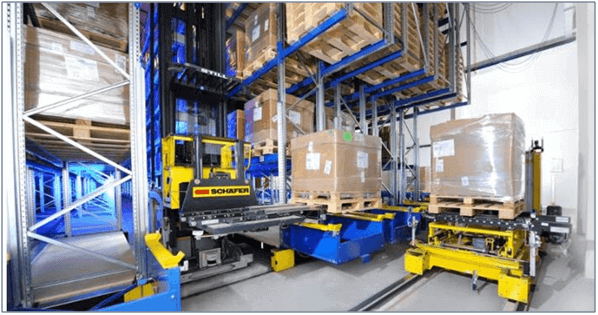In e-commerce sector, the interaction of human and technology is key to success in the evermore competitive market. With the conveniences provided by smart devices, consumers could easily conduct research and make instant purchase through the growing number of e-commerce platforms. Online shopping has become normal consumption for millions of consumers around the world on a daily basis.
At the same time, the evolution of technologies is helping to bring about tremendous improvement to logistics and warehouse management, enabling various modes of collaborative workflows between human and robot. With the smarter technology and warehouse system, fulfillment process is now more efficient and accurate thereby reducing logistics and warehousing errors and improves work quality.
Table of Contents
Artificial Intelligence for E-commerce
Artificial intelligence is now deeply embedded in our daily lives. With the rapid growth of AI capability, machines are expected to assist in simple or repetitive tasks, human could than focus more on things that requires more human ingenuity & creativity.
These machines, together with latest 5G technology & connectivity via internet of things, will bring life-changing evolution in the decades to come.The evolution in AI technology in e-commerce will be life & death for all e-commence company in coming years.
AI allow organizations to collect and analyze big data in real time, thereby allowing businesses to be more efficient at operation end like inventory and logistic management, and at the other far end, personalizing customer experience to maximize sales.
AI in an automated warehouse will enable machines to learn through experience, standardize new processes, and at the same time continuously improving performance and maximizing efficiency and ultimately profit in the most competitive environment. Artificial intelligence will also expand the potential of automation & robotic application, for example computerizing all fulfillment processes, like accurately lifting, fetching and handling without fatigue.

An Automated Warehouse
In the development of automated warehouses, storage, delivery and requisition work can be realized with minimum human supervising or may even eliminate the need of human involvement. In an automated warehouse, automatic racking structures, for example, will have the system to track even a single item in storage and precious inventory control to eliminate spoilage or damages. The upfront investment cost will be extremely high; however, the substantial improvement of efficient & long-term cost reduction certainly outweighs the cost. Recently Amazon USA had been repeatedly criticized for its labour practice in fulfilment centres throughout United States. Amazon was forced to compromise and improve on the working conditions after labour strike.

Warehouse Management System
Warehouse management system is a comprehensive software system that can organize all the important data into one platform. It can be easily accessed by internal participants and members in the supply chain. This compartmentalizing of data makes lightning-fast reporting, which translate into more efficient planning, even for situations one might not expect. All in all, the use of warehouse management or warehouse execution systems perfectly complement other automation elements. At any point of time, the supply chain may deal with hundreds or even tens of thousands of inventories from all over the world. With the right warehouse management system implemented, the team, for example could automatically identify the products via RFID technology, and then perform the order fulfillment process at the instant of click of a computer button. In this process, the manual workload can be greatly reduced, increases the efficiency of warehouse management, and reduce picking errors. The application of WMS system starts from receiving, put-away, inventory management, order processing, replenishment, picking / packing and monitoring of the delivery process.

QR Codes and Smart-phones for Inventory Management
QR code is commonly used nowadays. We can quickly and easily access to information by simply scanning the QR code. The storage capacity of the QR code far exceeded the limit of the conventional one-dimensional barcode. Inventory management software that uses QR codes could help track and analyze inventory. In one scan, we can upload more details information than barcode, and spend less time manually entering for customization. It enables better and faster data for inventory management. By implementing QR code system, the warehouse personnel can scan the QR code using designated device or any simple smartphone to check and track any inventory items. The specific information of the products is automatically identified and simplifies the inventory management procedure.
Automated Picking Technologies
In the logistics industry, will encounter many types of objects, different kinds of objects to manage is a certain difficulty.
A variety of tools can be used to improve the picking process, such as voice picking, robotic order picking, pick-to light etc. These technologies also take advantage of using of barcode that seamlessly integrate with the management software to provide the fastest and most accurate reporting. Fulfilment can be done with the use of robotics, starting with transfer of the products from inventory, to packaging and labelling for final delivery. Picking technology can help to increase efficiency, reduce picking errors, increase accuracy, productivity, flexibility and improve customer service to meet just-in-time order fulfillment.

Automatic Guided Vehicles (AGVs)
AGVs are designed specifically to transport materials in warehouse. They are used in many warehouses and industries to compensate for the shortages of manpower, reduce labor costs and improve warehouse efficiency. AGVs can significantly reduce damage to goods and industrial accidents in facilities. AGVs come in various versatile forms, it can be functioned with pallets, racks, and other container storage, and even automating the entire receiving process. AGVs are proven to optimize processes and improve efficiency, thereby providing good return of investment (ROI).

AR and VR for E-commerce Fulfillment
Augmented Reality (AR) and Virtual Reality (VR) could be used to improve efficiency in the logistics sector. Although the setup costs associated with AR and VR are relatively high, many companies are reported to strongly believe that they could have significant savings and improvement of operation efficiency. Use of AR devices, which include a head-up display (HUD) field for warehouse, enables the human operator to improve picking accuracy and productivity. DHL successfully tested the use of AR glass in picking operations in 8 facilities around the world since 2015.
The full content is only visible to SIPMM members
Already a member? Please Login to continue reading.
References
Aircargonews. (2019). “DHL Express Collaborates with EHang on Last-mile dDoneDelivery”. Retrieved from https://www.aircargonews.net/sectors/express/dhl-express-collaborates-with-ehang-on-last-mile-drone-delivery/ , accessed 6/12/2020.
Jenn Vande Zande. (2018). “The best examples of AI in e-commerce”. Retrieved from https://www.the-future-of-commerce.com/2018/01/26/artificial-intelligence-in-e-commerce-best-examples/ , accessed 8/12/2020.
Leong Jian Jie, ADLSM. (2019). “Key Digital Technologies for a Smart Warehouse”. Retrieved from https://publication.sipmm.edu.sg/key-digital-technologies-smart-warehouse/, accessed 7/12/2020.
Loadmaster Group. (2020). “Automated Guided Vehicles”. Retrieved from: https://www.lodamaster.com/en/solutions/automated-guided-vehicles, accessed 6/12/2020.
Mike O’Brien. (2018). “Augmented Reality Increasing Efficiency for Ecommerce Fulfillment”. Retrieved from https://multichannelmerchant.com/operations/augmented-reality-increasing-efficiency-for-ecommerce-fulfillment/,accessed 6/12/2020.
Schmidt Electronics. (2014). “Warehouse Management System (WMS)”. Retrieved from http://www.schmidtasia.com/sg/products/auto-id/software/automation/warehouse-management-system, accessed 7/12/2020.
Shahzad Karachiwala. (2020). “Can I Use QR Codes for Inventory?” Retrieved from https://www.sortly.com/blog/can-i-use-qr-codes-for-inventory, accessed 7/12/2020.
Shankar Kumar, DLSM. (2019). “Technologies for More Productive Warehousing”. Retrieved from SIPMM: https://publication.sipmm.edu.sg/technologies-more-productive-warehousing/, accessed 6/12/2020.
Shelly Stazzone (2020). “7 Smart Warehouse Technologies to Implement Today”. Retrieved from https://www.camcode.com/asset-tags/smart-warehouse-technologies/, accessed 6/12/2020.



